Personal Heating in Dwellings as an Innovative, Energy-Sufficient Heating Practice: A Case Study Research
Abstract
:1. Introduction
1.1. Background
1.2. Review of Personal Heating Studies
1.2.1. Chair Heaters
1.2.2. Foot and Hand Warmers
1.2.3. Combination of Techniques (Chairs, Foot and Wrist Warmers)
1.2.4. Infrared Heaters
1.2.5. Other Techniques
1.3. Research Gap and Hypothesis
2. Materials and Methods
2.1. Experiment Description
2.2. Implemented Personal Heating Systems
2.3. Evaluation Methods
2.3.1. Survey
2.3.2. Diary
2.3.3. Energy and Temperature Loggers
2.4. Statistical Data Analysis
2.5. Limitations of This Research
3. Results
3.1. Environment
3.1.1. Outdoor Temperature
3.1.2. Indoor Temperature
3.2. Diaries on the Personal Heating Practice
3.3. Thermal Comfort Results Collected by the “Right Here Right Now” Survey
3.3.1. Living Room
Thermal Sensation and Thermal Comfort in the Living Room during the Entire Experimental Period
Thermal Sensation and Thermal Comfort in the Living Room While Making Use of Active Personal Heating Elements
3.3.2. Dining Room
Thermal Sensation and Thermal Comfort in the Dining Room during the Entire Experimental Period
3.3.3. Thermal Sensation and Thermal Comfort in the Dining Room While Making Use of Active Personal Heating Elements
3.3.4. Kitchen
Kitchen Worktop
Kitchen Table
3.3.5. Bathroom
3.4. Energy-Saving Potential
3.4.1. Energy Consumption of the Personal Heating Systems during the Experiment
3.4.2. Energy Savings by Reducing the Heating Set-Point
3.4.3. Energy-Saving Potential of a Personal Heating Practice
4. Discussion
4.1. Evaluation of Personal Heating with Regard to Thermal Comfort
4.2. Effective Thermal Sensation in Relation to the Predicted Mean Vote
4.3. Effectiveness of the Different Personal Heating Systems
4.4. Evaluation of Personal Heating with Regard to Energy Savings
4.5. A personal Heating Practice in Relation to the Global Challenges
5. Conclusions
Author Contributions
Funding
Institutional Review Board Statement
Informed Consent Statement
Conflicts of Interest
References
- World Economic Forum. Global Challenges. 2020. Available online: https://www.weforum.org/focus/global-challenges-20 (accessed on 11 March 2021).
- IPCC. Climate Change 2013: The Physical Science Basis. Contribution of Working Group I to the Fifth Assessment Report of the Intergovernmental Panel on Climate Change; IPCC: Cambridge, UK; New York, NY, USA, 2013; p. 1535. [Google Scholar]
- European Commission. Energy Performance of Building Directive. 2020. Available online: https://ec.europa.eu/energy/topics/energy-efficiency/energy-efficient-buildings/energy-performance-buildings-directive_en (accessed on 3 March 2021).
- Abergel, T.; Dean, B.; Dulac, J. Towards a zero-emission, efficient, and resilient buildings and construction sector: Global Status Report 2017. UN Environ. Int. Energy Agency Paris Fr. 2017, 22, 1–48. [Google Scholar]
- FODEConomie. Analyse van Het Energieverbruik van Huishoudens in Belgie; FOD Economie, K.M.O.; Middenstand en Energie: Brussels, Belgium, 2018.
- Jespers, K.; Dufait, N. Energiebalans Vlaanderen 1990–2017; Vlaams Energieagentschap: Brussels, Belgium, 2019. [Google Scholar]
- Thomas, S.; Brischke, L.A.; Thema, J.; Kopatz, M. Energy Sufficiency Policy: An Evolution of Energy Efficiency Policy or Radically New Approaches? Eceee: Stockholm, Sweden, 2015. [Google Scholar]
- Fischer, C.C.; Tibbetts, K.J.; Morgan, D.; Ceder, G. When less is more. Nat. Mater. 2006, 5, 641–646. [Google Scholar] [CrossRef]
- Hamilton, I.G.; Summerfield, A.J.; Shipworth, D.; Steadman, J.P.; Oreszczyn, T.; Lowe, R.J. Energy efficiency uptake and energy savings in English houses: A cohort study. Energy Build. 2016, 118, 259–276. [Google Scholar] [CrossRef] [Green Version]
- Lorek, S.; Spangenberg, J.H. Energy sufficiency through social innovation in housing. Energy Policy 2019, 126, 287–294. [Google Scholar] [CrossRef]
- Rees, W.E. The ecological crisis and self-delusion: Implications for the building sector. Build. Res. Inf. 2009, 37, 300–311. [Google Scholar] [CrossRef] [Green Version]
- Kovacic, I.; Reisinger, J.; Honic, M. Life Cycle Assessment of embodied and operational energy for a passive housing block in Austria. Renew. Sustain. Energy Rev. 2018, 82, 1774–1786. [Google Scholar] [CrossRef]
- Röck, M.; Saade, M.R.M.; Balouktsi, M.; Rasmussen, F.N.; Birgisdottir, H.; Frischknecht, R.; Habert, G.; Lützkendorf, T.; Passer, A. Embodied GHG emissions of buildings-The hidden challenge for effective climate change mitigation. Appl. Energy 2020, 258, 114107. [Google Scholar] [CrossRef]
- Peeters, L.; Van Der Veken, J.; Hens, H.; Helsen, L.; D’Haeseleer, W. Control of heating systems in residential buildings: Current practice. Energy Build. 2008, 40, 1446–1455. [Google Scholar] [CrossRef]
- Van Loy, N.; Verbeeck, G.; Knapen, E. Analysis of accurate spatial use patterns within rooms for optimizing heating systems. In Young Researchers in Sustanable Building; CTU: Prague, Czech Republic, 2019. [Google Scholar]
- Van Loy, N.; Verbeeck, G.; Knapen, E. Potential of spatial use patterns for developing localized conditioning systems to reduce energy consumption. In E3S Web of Conferences; EDP Sciences: Bucharest, Romania, 2019; Volume 111. [Google Scholar]
- Darby, S.; Fawcett, T. Energy Sufficiency: A Concept Paper for ECEEE; European Council for an Energy-Efficient Economy, Environmental Change Institute, University of Oxford: Oxford, UK, 2018; Available online: https://www.energysufficiency.org/static/media/uploads/site-8/library/papers/sufficiency-introduction-final-oct2018 (accessed on 15 October 2020).
- Bierwirth, A.; Thomas, S. Energy sufficiency in buildings. In ECEEE Workshop ‘Energy Sufficiency: Key Messages for Policy Makers’; Eceee: Geneva, Switzerland, 2018. [Google Scholar]
- Humphreys, M.; Nicol, F.; Roaf, S. Keeping warm in a cooler house. Hist. Scotl. Tech. Pap. 2011, 14, 1–28. [Google Scholar]
- Deng, Q.; Wang, R.; Li, Y.; Miao, Y.; Zhao, J. Human thermal sensation and comfort in a non-uniform environment with personalized heating. Sci. Total. Environ. 2017, 578, 242–248. [Google Scholar] [CrossRef]
- Yang, H.; Cao, B.; Zhu, Y. Study on the effects of chair heating in cold indoor environments from the perspective of local thermal sensation. Energy Build. 2018, 180, 16–28. [Google Scholar] [CrossRef]
- Pasut, W.; Zhang, H.; Arens, E.; Zhai, Y. Energy-efficient comfort with a heated/cooled chair: Results from human subject tests. Build. Environ. 2015, 84, 10–21. [Google Scholar] [CrossRef] [Green Version]
- Pasut, W.; Zhang, H.; Arens, E.; Kaam, S.; Zhai, Y. Effect of a heated and cooled office chair on thermal comfort. HVAC R Res. 2013, 19, 574–583. [Google Scholar]
- Zhang, Y.F.; Wyon, D.P.; Fang, L.; Melikov, A.K. The influence of heated or cooled seats on the acceptable ambient temperature range. Ergonomics 2007, 50, 586–600. [Google Scholar] [CrossRef] [PubMed]
- Shahzad, S.; Calautit, J.K.; Calautit, K.; Hughes, B.; Aquino, A.I. Advanced personal comfort system (APCS) for the workplace: A review and case study. Energy Build. 2018, 173, 689–709. [Google Scholar] [CrossRef] [Green Version]
- Zhang, H.; Arens, E.; Taub, M.; Dickerhoff, D.; Bauman, F.; Fountain, M.; Pasut, W.; Fannon, D.; Zhai, Y.; Pigman, M. Using footwarmers in offices for thermal comfort and energy savings. Energy Build. 2015, 104, 233–243. [Google Scholar] [CrossRef] [Green Version]
- Kong, M.; Dang, T.Q.; Zhang, J.; Khalifa, H.E. Micro-environmental control for efficient local heating: CFD simulation and manikin test verification. Build. Environ. 2019, 147, 382–396. [Google Scholar] [CrossRef]
- Zhang, H.; Arens, E.; Kim, D.; Buchberger, E.; Bauman, F.; Huizenga, C. Comfort, perceived air quality, and work performance in a low-power task–ambient conditioning system. Build. Environ. 2010, 45, 29–39. [Google Scholar] [CrossRef] [Green Version]
- He, Y.; Wang, X.; Li, N.; He, M.; He, D. Heating chair assisted by leg-warmer: A potential way to achieve better thermal comfort and greater energy conservation in winter. Energy Build. 2018, 158, 1106–1116. [Google Scholar] [CrossRef]
- Oi, H.; Yanagi, K.; Tabata, K.; Tochihara, Y. Effects of heated seat and foot heater on thermal comfort and heater energy consumption in vehicle. Ergonomics 2011, 54, 690–699. [Google Scholar] [CrossRef]
- Luo, M.; Arens, E.; Zhang, H.; Ghahramani, A.; Wang, Z. Thermal comfort evaluated for combinations of energy-efficient personal heating and cooling devices. Build. Environ. 2018, 143, 206–216. [Google Scholar] [CrossRef] [Green Version]
- Veselý, M.; Molenaar, P.; Vos, M.; Li, R.; Zeiler, W. Personalized heating-Comparison of heaters and control modes. Build. Environ. 2017, 112, 223–232. [Google Scholar] [CrossRef] [Green Version]
- Watanabe, S.; Melikov, A.K.; Knudsen, G.L. Design of an individually controlled system for an optimal thermal microenvironment. Build. Environ. 2010, 45, 549–558. [Google Scholar] [CrossRef]
- Li, Z.; Ke, Y.; Wang, F.; Yang, B. A study of thermal comfort enhancement using three energy-efficient personalized heating strategies at two low indoor temperatures. Build. Environ. 2018, 143, 1–14. [Google Scholar]
- Foda, E.; Sirén, K. Design strategy for maximizing the energy-efficiency of a localized floor-heating system using a thermal manikin with human thermoregulatory control. Energy Build. 2012, 51, 111–121. [Google Scholar] [CrossRef]
- Lodi, C.; Magli, S.; Contini, F.M.; Muscio, A.; Tartarini, P. Improvement of thermal comfort and energy efficiency in historical and monumental buildings by means of localized heating based on non-invasive electric radiant panels. Appl. Therm. Eng. 2017, 126, 276–289. [Google Scholar] [CrossRef]
- Melikov, A.K.; Langkilde, G.; Rasmussen, L.W. Human response to local heating for use in connection with low enthalpy ventilation. Proc. ROOMVENT 1998, 315321, 315–322. [Google Scholar]
- Conceição, E.; Lúcio, M.M.J. Evaluation of thermal comfort conditions in a localized radiant system placed in front and behind two students seated nearby warmed curtains. Build. Environ. 2010, 45, 2100–2110. [Google Scholar] [CrossRef]
- Wang, Z.; Warren, K.; Luo, M.; He, X.; Zhang, H.; Arens, E.; Chen, W.; He, Y.; Hu, Y.; Jin, L.; et al. Evaluating the comfort of thermally dynamic wearable devices. Build. Environ. 2020, 167, 106443. [Google Scholar] [CrossRef]
- Kim, J.; Bauman, F.; Raftery, P.; Arens, E.; Zhang, H.; Fierro, G.; Andersen, M.; Culler, D. Occupant comfort and behavior: High-resolution data from a 6-month field study of personal comfort systems with 37 real office workers. Build. Environ. 2019, 148, 348–360. [Google Scholar] [CrossRef]
- Zhou, L.; Li, N.; He, Y.; Zhang, J.; Lu, J.; Han, Y. Field Study on Thermal Comfort and Adaptive Behaviours with a Personal Heating Device in Hunan. In Proceedings of the Soil and Recycling Management in the Anthropocene Era, Harbin, China, 12–15 July 2019; Springer Science and Business Media LLC: Singapore, 2020; pp. 669–677. [Google Scholar]
- Wang, H.; Xu, M.; Bian, C. Experimental comparison of local direct heating to improve thermal comfort of workers. Build. Environ. 2020, 177, 106884. [Google Scholar] [CrossRef]
- Zhang, Y.; Zhao, R. Relationship between thermal sensation and comfort in non-uniform and dynamic environments. Build. Environ. 2009, 44, 1386–1391. [Google Scholar] [CrossRef]
- Veselý, M.; Zeiler, W. Personalized conditioning and its impact on thermal comfort and energy performance—A review. Renew. Sustain. Energy Rev. 2014, 34, 401–408. [Google Scholar] [CrossRef] [Green Version]
- Rawal, R.; Schweiker, M.; Kazanci, O.B.; Vardhan, V.; Jin, Q.; Duanmu, L. Personal comfort systems: A review on comfort, energy, and economics. Energy Build. 2020, 214, 109858. [Google Scholar] [CrossRef]
- Guerra-Santin, O.; Tweed, C.A. In-use monitoring of buildings: An overview of data collection methods. Energy Build. 2015, 93, 189–207. [Google Scholar] [CrossRef]
- KMI. Klimatologische Overzichten. Available online: https://www.meteo.be/nl/klimaat/klimatologisch-overzicht (accessed on 21 January 2021).
- Eurostat. Energy Statistics-Cooling and Heating Degree Days. 2020. Available online: https://ec.europa.eu/eurostat/cache/metadata/en/nrg_chdd_esms.htm (accessed on 29 January 2021).
- Chen, C.-F.; Hong, T.; de Rubens, G.Z.; Yilmaz, S.; Bandurski, K.; Bélafi, Z.D.; De Simone, M.; Bavaresco, M.V.; Wang, Y.; Liu, P.-L.; et al. Culture, conformity, and carbon? A multi-country analysis of heating and cooling practices in office buildings. Energy Res. Soc. Sci. 2020, 61, 101344. [Google Scholar] [CrossRef]
- Standardization, I.O.f. ISO 7730 2005-11-15 Ergonomics of the Thermal Environment: Analytical Determination and Interpretation of Thermal Comfort Using Calculation of the PMV and PPD Indices and Local Thermal Comfort Criteria. Management 2005, 3, e615. [Google Scholar]
- Ghahramani, A.; Zhang, K.; Dutta, K.; Yang, Z.; Becerik-Gerber, B. Energy savings from temperature setpoints and deadband: Quantifying the influence of building and system properties on savings. Appl. Energy 2016, 165, 930–942. [Google Scholar] [CrossRef] [Green Version]
- Hoyt, T.; Arens, E.; Zhang, H. Extending air temperature setpoints: Simulated energy savings and design considerations for new and retrofit buildings. Build. Environ. 2015, 88, 89–96. [Google Scholar] [CrossRef] [Green Version]
- Verhaart, J.J.; Vesely, M.M.; Zeiler, W.W. Personal heating: Effectiveness and energy use. Build. Res. Inf. 2015, 43, 346–354. [Google Scholar] [CrossRef] [Green Version]
- Nicol, F.; Humphreys, M.; Roaf, S. Adaptive Thermal Comfort: Principles and Practice; Routledge: London, UK, 2012. [Google Scholar]
- Bierwirth, A.; Thomas, S. Energy Sufficiency in Buildings: Concept Paper; Eceee: Geneva, Switzerland, 2019. [Google Scholar]
- Fuentes, E.; Arce, L.; Salom, J. A review of domestic hot water consumption profiles for application in systems and buildings energy performance analysis. Renew. Sustain. Energy Rev. 2018, 81, 1530–1547. [Google Scholar] [CrossRef]
- O’Brien, W.; Gunay, H.B. The contextual factors contributing to occupants’ adaptive comfort behaviors in offices-A review and proposed modeling framework. Build. Environ. 2014, 77, 77–87. [Google Scholar] [CrossRef]
- Becker, R.; Paciuk, M. Thermal comfort in residential buildings-Failure to predict by Standard model. Build. Environ. 2009, 44, 948–960. [Google Scholar] [CrossRef]
- Zhang, H.; Arens, E.; Zhai, Y. A review of the corrective power of personal comfort systems in non-neutral ambient environments. Build. Environ. 2015, 91, 15–41. [Google Scholar] [CrossRef] [Green Version]
- André, M.; De Vecchi, R.; Lamberts, R. User-centered environmental control: A review of current findings on personal conditioning systems and personal comfort models. Energy Build. 2020, 222, 110011. [Google Scholar] [CrossRef]
- Marignac, Y. Energy Sufficiency as Part of Climate Action. 2019. Available online: www.climatedialogue.eu (accessed on 17 June 2021).
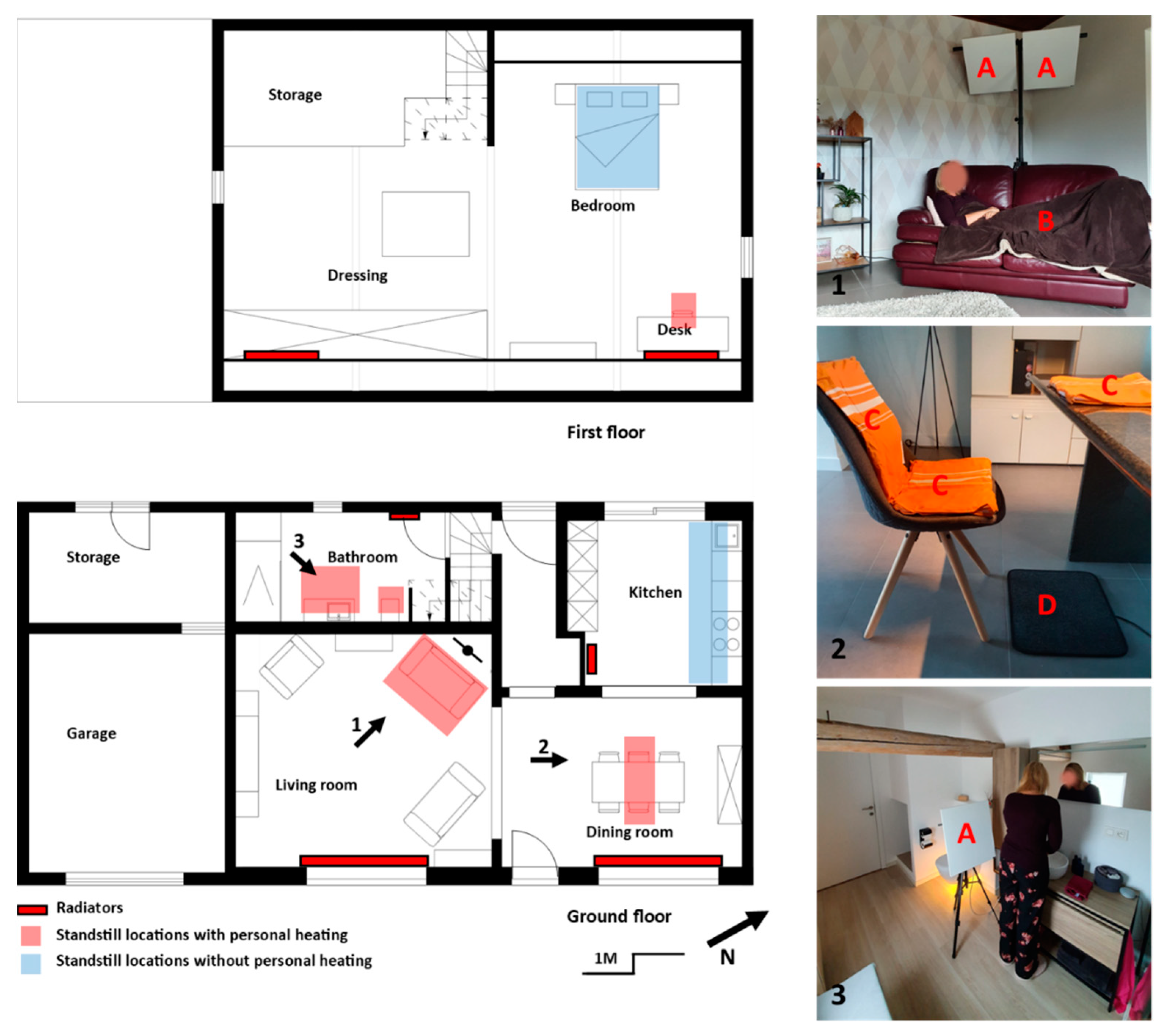
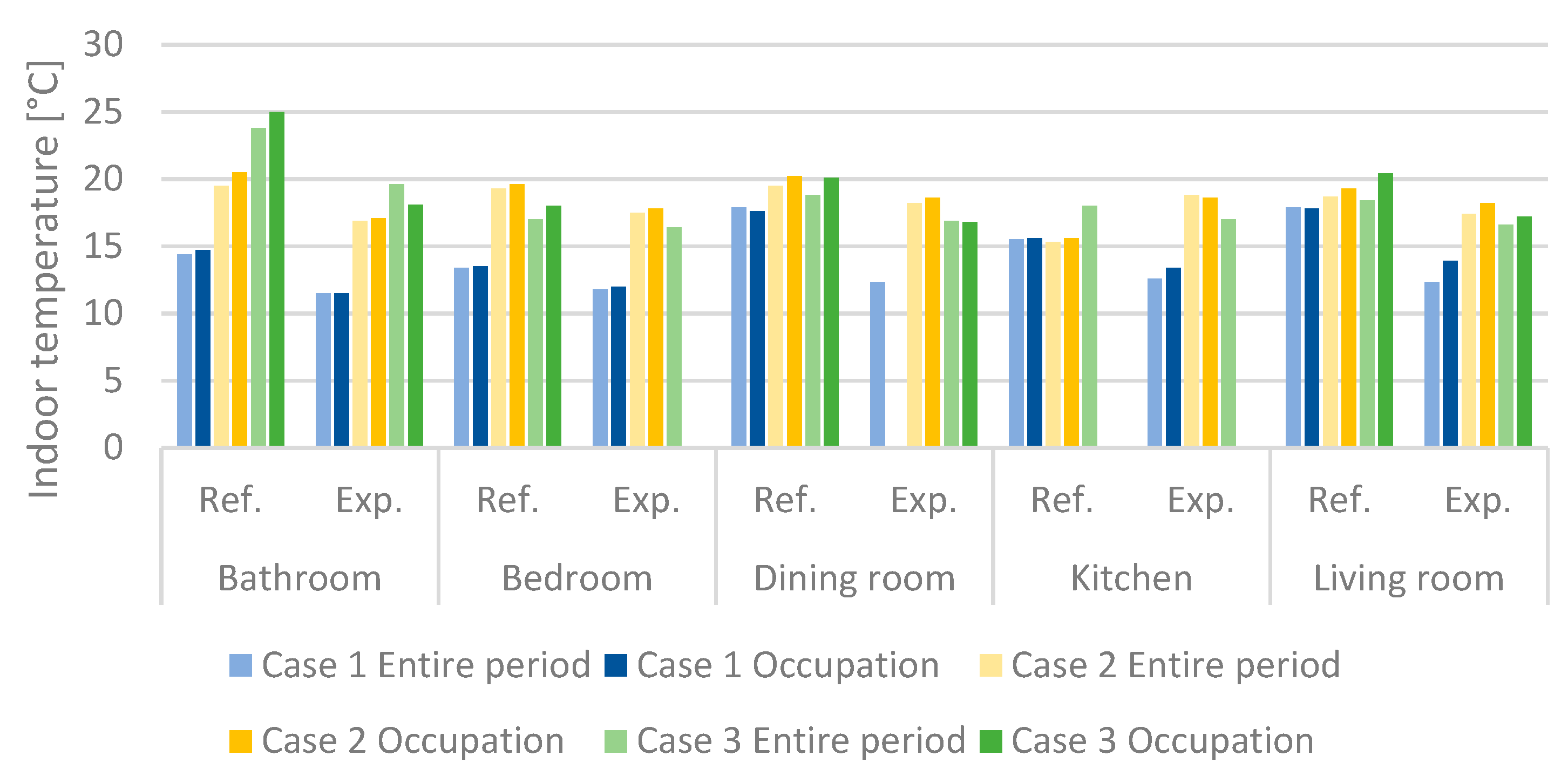
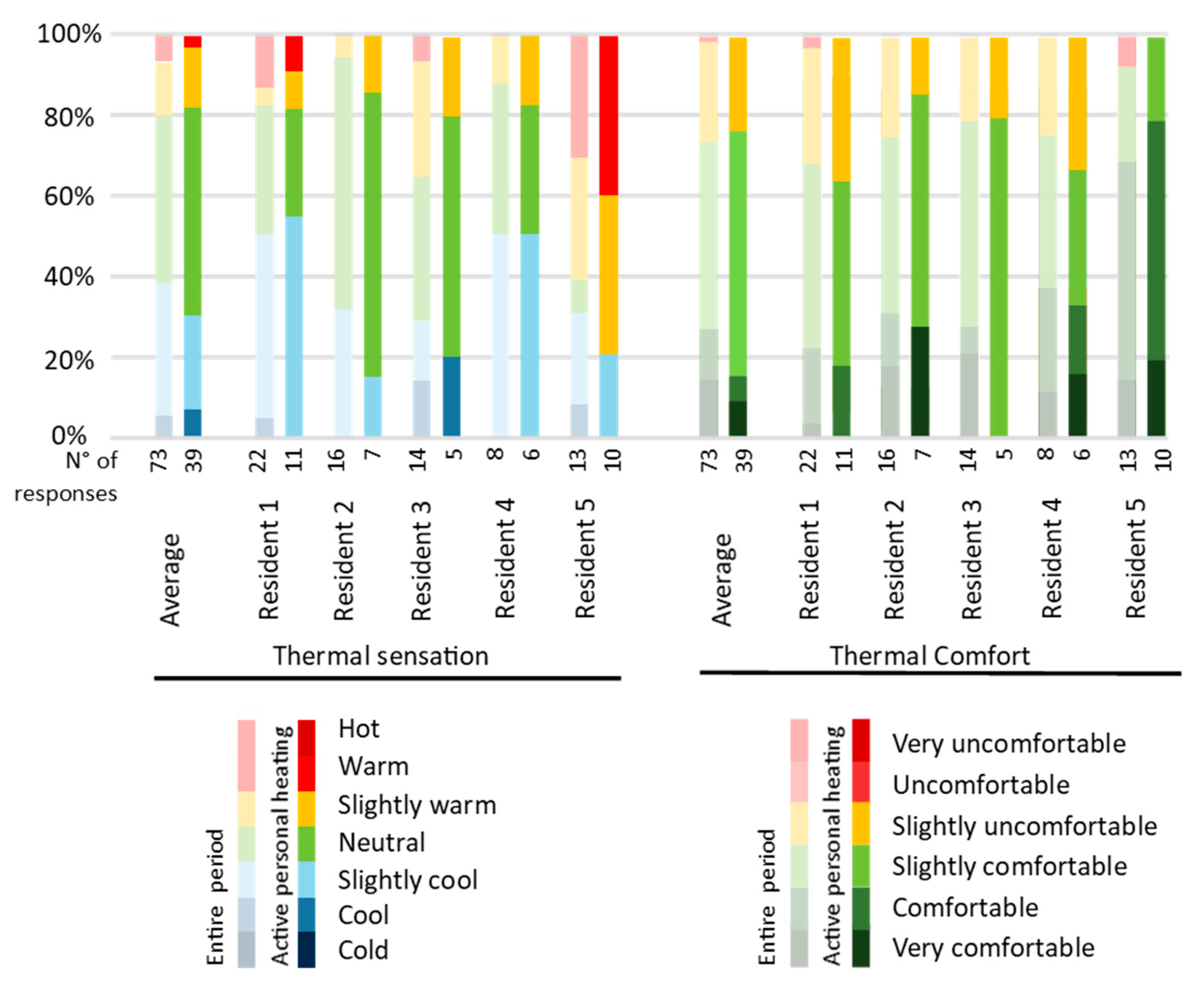
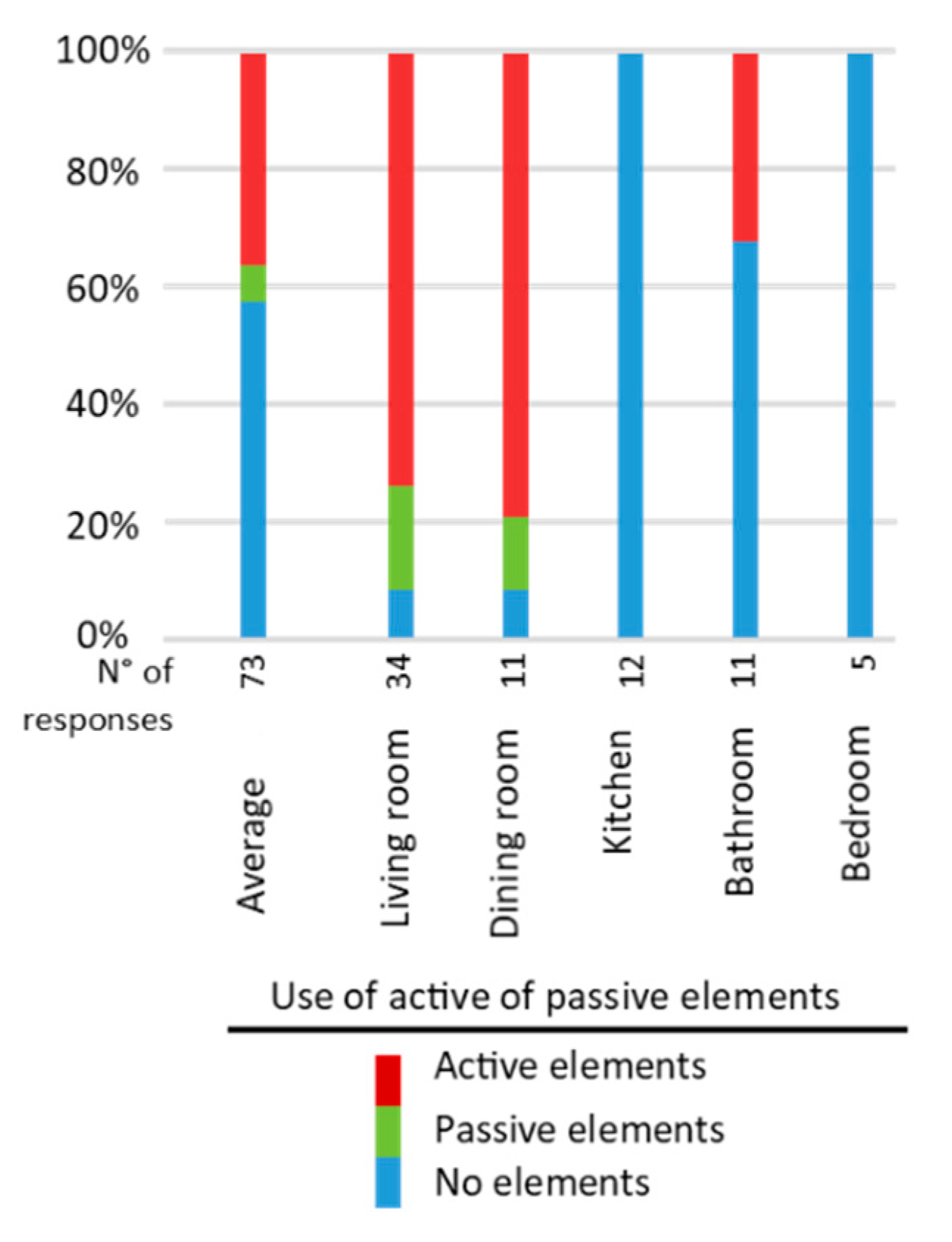



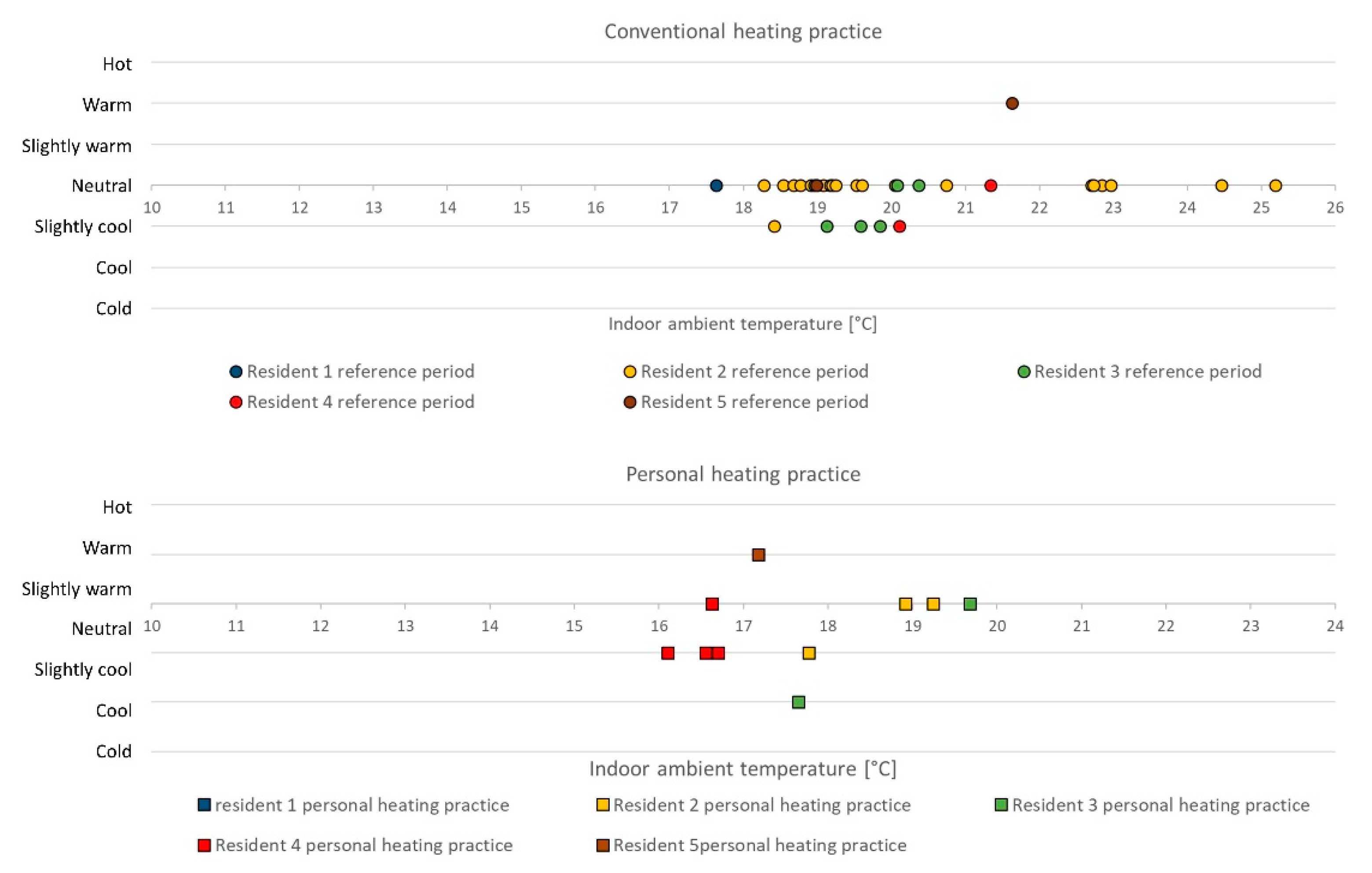
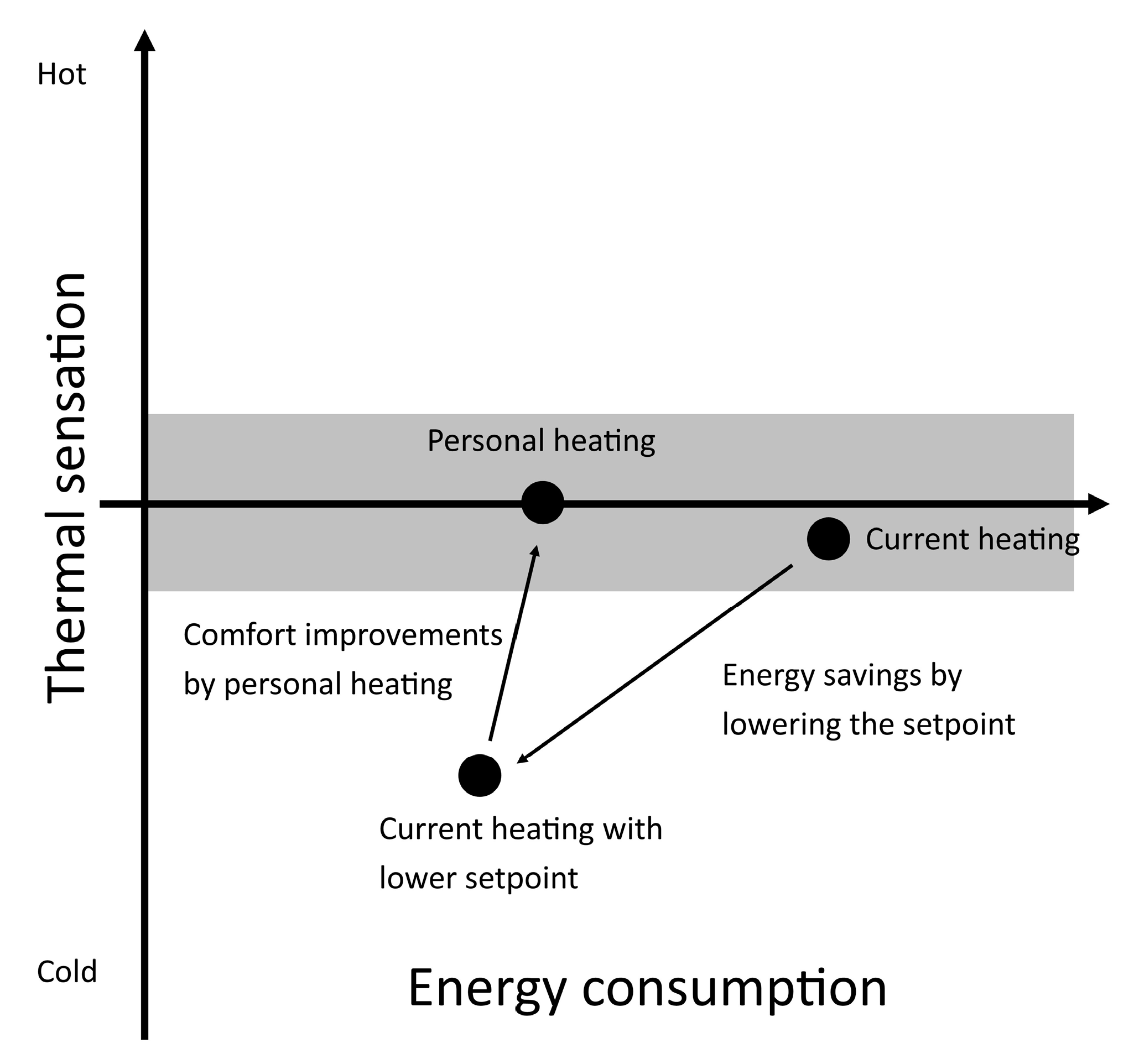
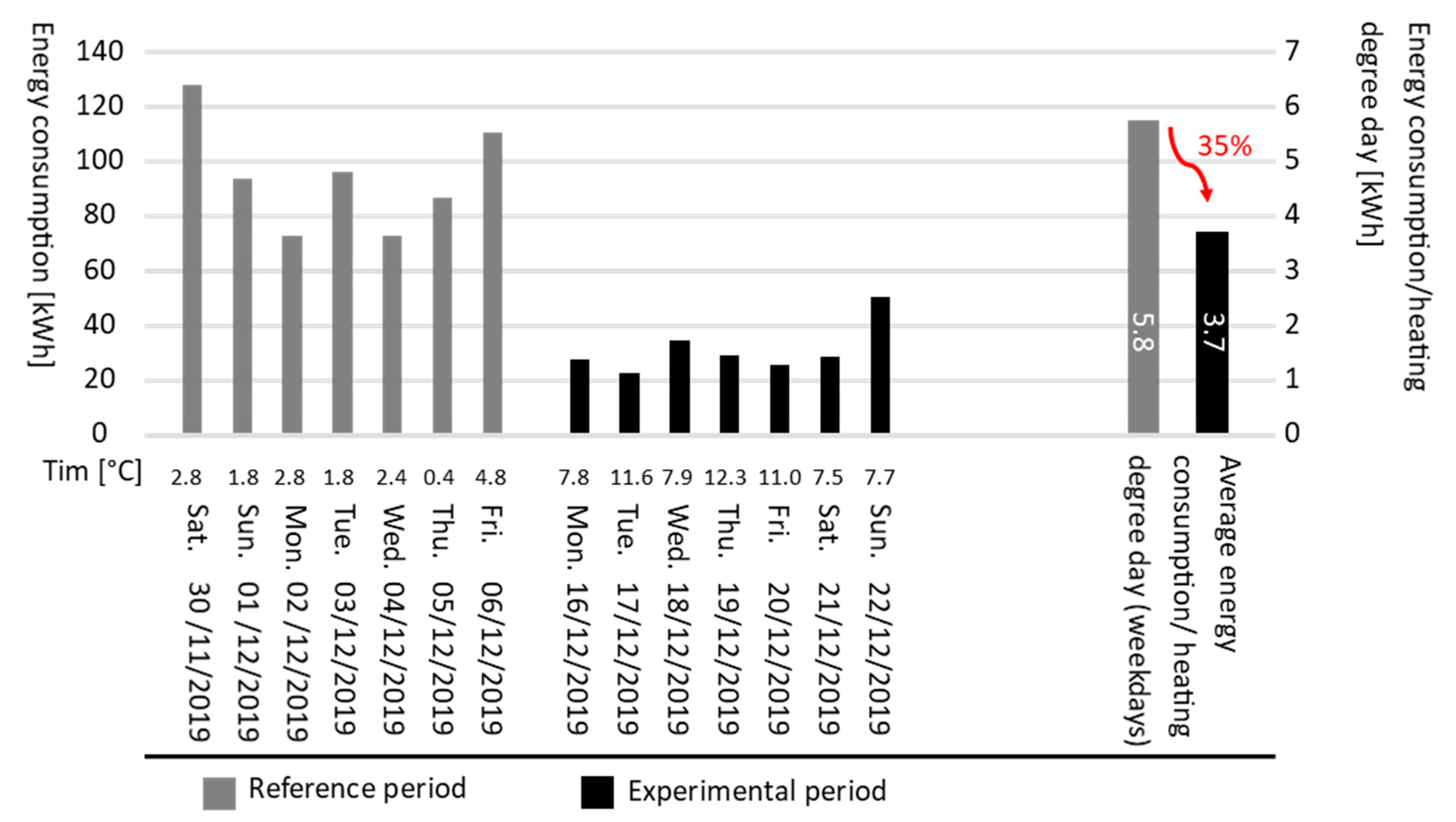

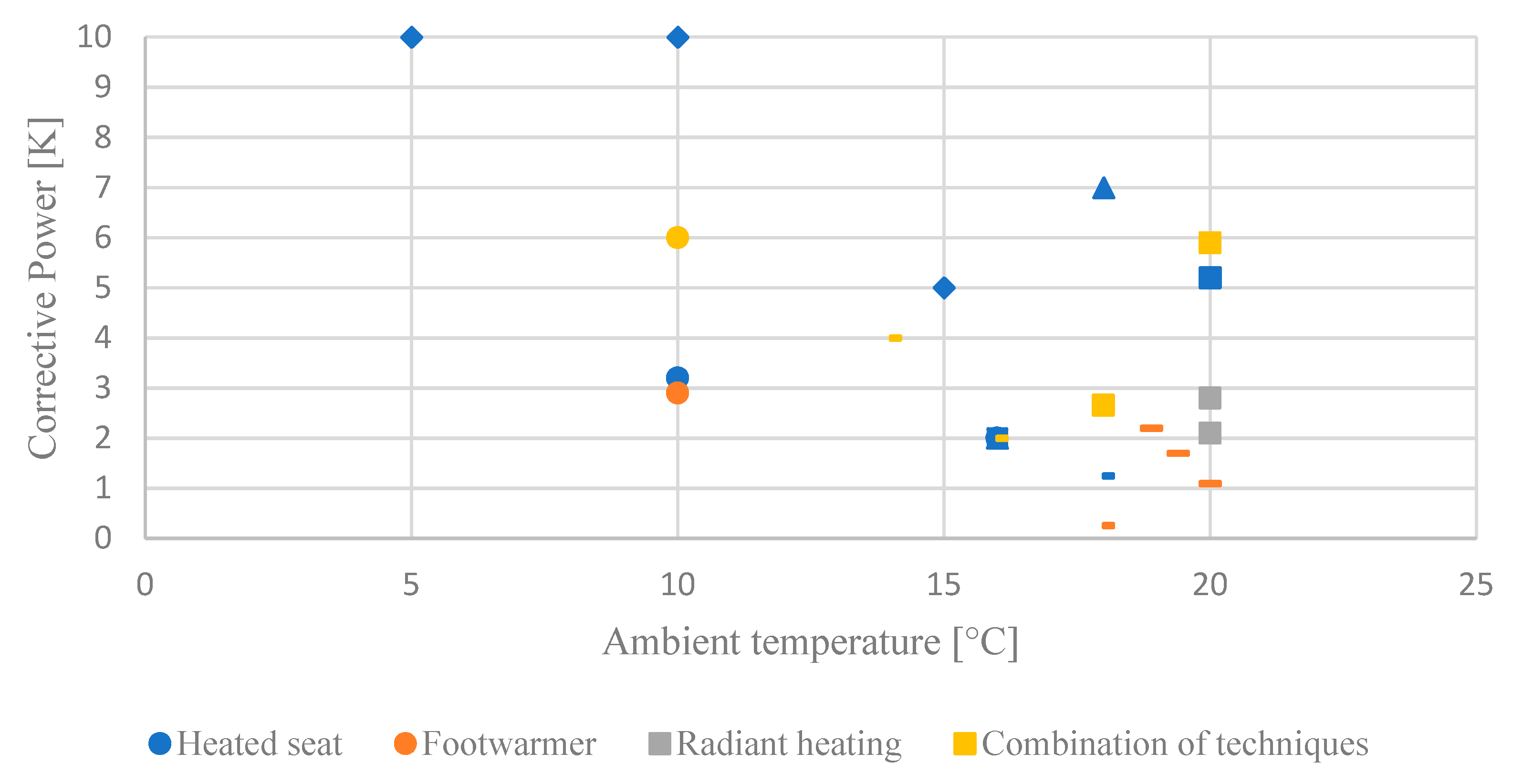
| N° | Ref. | Type of System | Type of Experiment (N° Subjects) | Individual Control | Ambient Temperature [°C] | Comfort/Energy | System/Practice |
|---|---|---|---|---|---|---|---|
| Study 1 | [20] | Heated chair | Climate chamber (32) | No | 16 | Thermal comfort | System |
| Study 2 | [21] | Heated chair | Climate chamber (13) | Yes | 14, 16, 18 | Thermal comfort | System |
| Study 3 | [22] | Heated chair | Climate chamber (23) | Yes | 18, 16 | Thermal comfort | System |
| Study 4 | [23] | Heated chair | Climate chamber (30) | Yes | 18, 16 | Thermal comfort | System |
| Study 5 | [24] | Heated chair | Climate chamber (24) | No | 22, 18, 15 | Thermal comfort | System |
| Study 6 | [25] | Heated chair | Simulations | - | - | Thermal comfort/energy | System/practice |
| Study 7 | [26] | Foot warmers (radiant) | Office building (16) | Yes | 20, 19.4, 18.9 | Thermal comfort/energy | System |
| Study 8 | [27] | Foot warmer | Thermal manikin/simulations | - | - | Thermal comfort | System |
| Study 9 | [28] | Palm warmer Foot warmer | Climate chamber (18) | No/Yes | 18, 20 | Thermal comfort/energy | System |
| Study 10 | [29] | Heated chair Leg-warmer | Climate chamber (16) | Yes | 14, 16, 18, 22 | Thermal comfort/energy | System |
| Study 11 | [30] | Heated seat Foot warmer Heated seat + foot warmer | Climate chamber (8) | - | 20, 10 | Thermal comfort | System |
| Study 12 | [31] | Heated chair Heated wrist pad Heated insole | Climate chamber (20)/thermal manikin | - | 18 | Thermal comfort/energy | System |
| Study 13 | [32] | Heated chair Heated desk mat Heated floor mat | Climate chamber (13) | Yes | 18 | Thermal comfort/energy | System |
| Study 14 | [33] | Heated chair Under-desk radiant heating panel Floor radiant heating panel | Thermal manikin | - | 20 | Thermal comfort | System |
| Study 15 | [34] | Radiant panel with heated table pad Heated chair with floor mattress Heated clothing | Climate chamber (14) | Yes | 15, 18 | Thermal comfort | System |
| Study 16 | [35] | Localized floor heating | Thermal manikin | - | - | Thermal comfort | System |
| Study 17 | [36] | Electric radiant panels | Simulation | - | 18 | Thermal comfort | System |
| Study 18 | [37] | Electric radiant panels | Climate chamber (18) | - | 20, 17, 14 | Thermal comfort | System |
| Study 19 | [38] | Electric radiant panels | Simulation | - | - | Thermal comfort | System |
| Study 20 | [39] | Wrist heater | Climate chamber (49) | No/Yes | 20, 23, 26 | Thermal comfort | System |
| Study 21 | [40] | Heated seat | Office building | Yes | - | Thermal comfort | System |
| Study 22 | [41] | Floor heater | Residential buildings | 8–14 | Thermal comfort | System | |
| Study 23 | [42] | Radiant heater, heated clothing | Climate chamber (20) | 13–15 | Thermal comfort | System |
| Dwelling 1 | Dwelling 2 | Dwelling 3 | |
|---|---|---|---|
| Residents | Single, 25–35 years old, man (n° 1) | Couple, 25–35 years old, man (n° 2) and woman (n° 3) | Couple, 25–35 years old, man (n° 4) and woman (n° 5) |
| Dwelling size | 162 m2 | 215 m2 | 148 m2 |
| Building year | 1990 | Before 1945 (renovated in 1972) | Before 1945 (partially renovated in 2019) |
| EPC 1 | 496 kWh/m2year | 370 kWh/m2 | 283 kWh/m2 |
| Heating system | Electric accumulation heaters (living, veranda) and electric heaters | Central heating on fuel oil with radiators and floor heating (dining room and bathrooms) | Energy-efficient central heating on gas with radiators |
| Infrared Panel | Heated Blanket | Heated Cushions | Floor Mat | |
|---|---|---|---|---|
| Maximum power | 350 W | 120 W | 100 W | 20 W |
| Controls | ON–OFF | 4 heating levels and OFF | 3 heating levels and OFF | ON–OFF |
| Question | Question Type | |
|---|---|---|
| 1 | Where are you exactly? (position within the room) | Single option |
| 2 | In which pose are you? (standing, sitting, lying) | Single option |
| 3 | Which activity are you performing? | Multiple options |
| 4 | How do you experience the indoor temperature right now? (thermal sensation) | Likert scale |
| 5 | What is your thermal comfort right now? (thermal comfort) | Likert scale |
| 6 | Which clothing type are you wearing? | Multiple options |
| 7 | How did you come to this comfort state? (e.g., just performed an activity or used a personal heating element) | Open questions |
| 8 | Do you experience any local discomfort? Where and how? | Open question |
| December 2019 | January 2020 | February 2020 | |
|---|---|---|---|
| Average outdoor temperature | 5.9 °C | 5.9 °C | 7.0 °C |
| Minimum outdoor temperature | −2.5 °C | −2.4 °C | −0.9 °C |
| Maximum outdoor temperature | 15.4 °C | 12.4 °C | 16.6 °C |
| Days minimum outdoor temperature < 0 °C | 6 | 6 | 2 |
| Days maximum outdoor temperature < 0 °C | 0 | 0 | 0 |
| Average winter outdoor temperature | 3.9 °C | 3.3 °C | 3.7 °C |
| Living Room Couch | Dining Room Dining Table | Kitchen Worktop/ Table | Bathroom | Total/ Day | ||||
|---|---|---|---|---|---|---|---|---|
| Type of Element | (2×) Infrared Panel | (2×) Blanket | (2×) Infrared Panel | (4×) Cushions (2×) Floor Mat | (4×) Cushions (2×) Floor Mat | (1×) Infrared Panel | ||
| Combined maximum power | 700 W | 240 W | 700 W | 440 W | 440 W | 350 W | ||
| Total energy consumption during the experiment | Case 1 10 days | 11.68 kWh | 1.13 kWh | 0 kWh | 0 kWh | 0 kWh | 0.03 kWh | 1.28 kWh |
| Case 2 7 days | 3.35 kWh | 1.38 kWh | 1.19 kWh | 0.32 kWh | 0 kWh | 0.01 kWh | 0.89 kWh | |
| Case 3 7 days | 5.18 kWh | 1.96 kWh | 0 kWh | 0.24 kWh | 0 kWh | 0.43 kWh | 1.11 kWh | |
| Average energy consumption/day | 0.80 kWh | 0.20 kWh | 0.06 kWh | 0.03 kWh | 0 kWh | 0.02 kWh | 1.10 kWh | |
Publisher’s Note: MDPI stays neutral with regard to jurisdictional claims in published maps and institutional affiliations. |
© 2021 by the authors. Licensee MDPI, Basel, Switzerland. This article is an open access article distributed under the terms and conditions of the Creative Commons Attribution (CC BY) license (https://creativecommons.org/licenses/by/4.0/).
Share and Cite
Van Loy, N.; Verbeeck, G.; Knapen, E. Personal Heating in Dwellings as an Innovative, Energy-Sufficient Heating Practice: A Case Study Research. Sustainability 2021, 13, 7257. https://doi.org/10.3390/su13137257
Van Loy N, Verbeeck G, Knapen E. Personal Heating in Dwellings as an Innovative, Energy-Sufficient Heating Practice: A Case Study Research. Sustainability. 2021; 13(13):7257. https://doi.org/10.3390/su13137257
Chicago/Turabian StyleVan Loy, Nick, Griet Verbeeck, and Elke Knapen. 2021. "Personal Heating in Dwellings as an Innovative, Energy-Sufficient Heating Practice: A Case Study Research" Sustainability 13, no. 13: 7257. https://doi.org/10.3390/su13137257
APA StyleVan Loy, N., Verbeeck, G., & Knapen, E. (2021). Personal Heating in Dwellings as an Innovative, Energy-Sufficient Heating Practice: A Case Study Research. Sustainability, 13(13), 7257. https://doi.org/10.3390/su13137257






